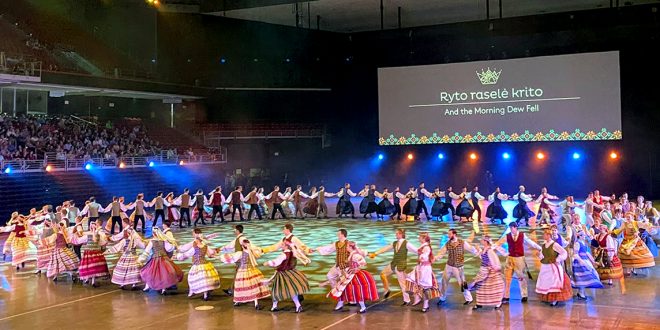Laima Vincė.
My first Lithuanian folk dance festival – as veterans of Lithuanian folk dance festivals like to say – took place in Cleveland in 1984. I danced with “Liepsna” from Elizabeth, New Jersey. We’d dance in the church hall, just like all over the United States and Canada, young Lithuanian emigres gathered to dance in their respective church halls. I’d started to dance in “Liepsna” just a few years before my first Lithuanian folk dance festival, when I was still a gangly teenager. I attended rehearsals with my elder brother, Vilius, and later my younger brothers, Andrius and Vincas, joined. In those days, we rehearsed to the accordion. Among Lithuanian Americans and Lithuanian Canadians, the role of the musician was particularly important because this chosen one set the tempo and mood of the dance. It was an honor for a family to prepare a child to play the accordion for the dance troupe. Emilija Sadonis, or as we called her, Emil, played the accordion for “Liepsna.” My brothers would dutifully suffer through high dance steps, polkas and spins, in anticipation of those hours we would all spend together later, after rehearsal was over, gathered at the bar with a beer, sharing jokes and stories.
My mother and her friend, who was also named Emilija, sewed my Lithuanian national costume. They embroidered the sleeves of my white blouse with delicate stiches and fine patterns, and embroidered the collar, apron, and my vest. After performances my mother would chide me when I stepped off the stage.
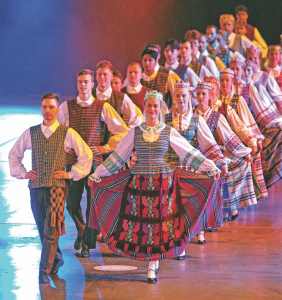
“All the other girls on stage are so neat and well groomed, but you are a mess! Your long hair always comes out of your braids, your apron is tied on crooked, and you always forget to tuck your blouse into your skirt,” she’d complain.
I wasn’t much of a dancer… I’d turn the wrong way, lose the rhythm, get my feet tangled, and worst of all – dear Lord – step on someone’s foot. But still, it was fun, even a lot of fun, to dance together and experience that sense of community that brought us together as Lithuanians.
The first Lithuanian folk dance festival took place in Chicago in 1957, only a little more than a decade after World War II had ended and less than a decade since the first displaced persons (DPs) crossed the Atlantic and began to settle in the United States and Canada. Rimas Česonis, Lithuanian Honorary Consul from Rochester, New York, still remembers how he danced in the first folk dance festival.
“I was young back then and I cared more about dancing with the pretty girls than I did about the Lithuanian community. But by participating in folk dancing I eventually matured, and I became an active, responsible Lithuanian.”
Ponia Birutė from Chicago, who is “somewhere between 80 and 90 years old,” laughed pleasantly as she reminisced over folk dances after the war.
“Back then we didn’t care how our dances looked to anyone else. We had fun getting together and dancing. We’d dance a polka, a waltz. We always danced to the accordion. These days they make a show out of the folk-dance festival and it’s really beautiful to watch, but we didn’t need all that… that… parading around… no, we just wanted to spend time together and dance.”
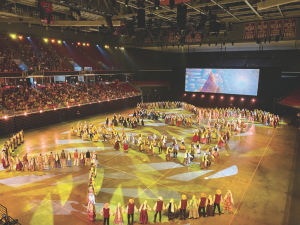 This year’s Lithuanian Folk Dance theme is “Tales of the Kings.” Story motives weave throughout the program and the theme is introduced in the festival catalogue:
This year’s Lithuanian Folk Dance theme is “Tales of the Kings.” Story motives weave throughout the program and the theme is introduced in the festival catalogue:
Stories were a very important part of Lithuanian life: you became acquainted with them in childhood, and during dark and gloomy nights. And later, having grown up and tossed by fate across the oceans, we told stories to our own children. So, by word of mouth, stories traveled over the centuries, enveloping children in the world of miracles and magic. Many immigrant mothers told stories to their children to replace the longing they felt for their homeland and the beauty of their birthplace, and the secretive mystery and the inexhaustible treasure of folk wisdom.
With these words, the Artistic Committee opens the theme of the “Tales of the Kings.” The paintings of the classic Lithuanian painter Mikalojus Konstantinas Čiurlionis provide the visual theme. Čiurlionis’s painting “The Tales of the Kings” gives the program an aura of magic as the predominant visual accent.
The dance program is divided into six parts: Prologue: The Beacon of Good Fortune, Part I: When the Rock Puntukas was Overturned, Part II: The Sun and the Moon, Part III: The Blacksmith Televelis, Part IV: Vaiva’s Sash, Part V: The Bird of Good Fortune. Each of the parts opens with a film on the large screen in the arena that shows a grandmother (played by Ona Daugirdienė) telling her grandson (played by Tauras Paulauskas) a story. When the storytelling segment finishes, the dancers embody elements of the story on stage through movement and dance. This is a completely original approach to envisioning the folk-dance festivals, which has come a long way since the days when Ponia Birutė and Rimas Česonis danced to the accordion in those early years of the Lithuanian folk dance festivals.
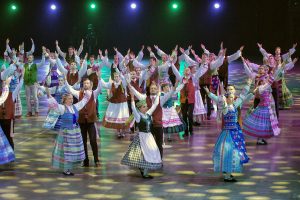 Gintaras Grinkevičius was the artistic director of the 16th Lithuanian Folk Dance Festival. He graduated from the Lithuanian State Conservatory in Klaipėda, earning a degree as a ballet master in pedagogy from the faculties of music, theater, and dance. Since 1994, he has served as the senior assistant ballet master and floor coordinator for Lithuania’s national song and dance festivals.
Gintaras Grinkevičius was the artistic director of the 16th Lithuanian Folk Dance Festival. He graduated from the Lithuanian State Conservatory in Klaipėda, earning a degree as a ballet master in pedagogy from the faculties of music, theater, and dance. Since 1994, he has served as the senior assistant ballet master and floor coordinator for Lithuania’s national song and dance festivals.
In 1994, he emigrated to the United States and began to work as a teacher with the Chicago Lithuanian dance ensemble “Grandis.”
Tadas Varaneckas served as the folk dance festival’s Assistant Artistic Director. Formally trained in a variety of styles of dance, he also attended the Ohio State University earning his Bachelor of Science degree in Computer Science and Engineering with a minor in Dance. He joined the Lithuanian Folk Dance Ensemble “Grandis” and has had the opportunity to participate in three North American Lithuanian Folk Dance Festivals.
The production director was Canadian Lithuanian Vytas Čuplinskas, who grew up in Toronto. He completed his degree in Interdisciplinary Fine Arts at York University. In 1989 he moved to Canada’s capital, where, for four years, he focused on lobbying the Canadian government to recognize Lithuania’s independence. A photographer, graphic designer, coder, lighting designer, cinematographer, set designer, film editor, director, and user experience professional, Vytas creates unique multimedia shows. Recent work includes the 2015 Lithuanian Song Festival and the 2018 February 16th event in Chicago.
This year the artistic committee was made up of the following professionals: Dr. Vidmantas Mačiulskis, Vitalija Ivinskis, Aušrinė Širvinskienė, Eimantas Žukauskas, Elena Maurukienė, Romas Janušonis. The organizing committee was led by Virgus L. Volertas and was made up of the following professionals: Kristina Volertienė, Krista Bard, Deimantė Kalinauskaitė, Kazimieras Deksnys, Sofija Volertienė, Virgus P. Volertas, Daiva Kazlauskas, Jonas Howes, Jr., Laima Liutkienė.
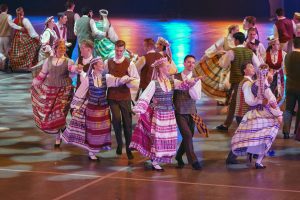 Seated in the Temple University Liacouras Center, while waiting for the stadium to fill up and for the show to begin, I started a conversation with Rimas Česonis, the Honorary Consul of Rochester, New York. He is of the older generation, those who were born in Lithuania or in the DP camps of Germany, and who had emigrated to the United States as children. Seated beside him was his son, Arūnas.
Seated in the Temple University Liacouras Center, while waiting for the stadium to fill up and for the show to begin, I started a conversation with Rimas Česonis, the Honorary Consul of Rochester, New York. He is of the older generation, those who were born in Lithuania or in the DP camps of Germany, and who had emigrated to the United States as children. Seated beside him was his son, Arūnas.
“What does the Lithuanian Folk Dance Festival mean to you?” I asked.
“My son Arūnas danced with three groups, and then he grew out of a dancer into a successful businessman who sits on the MIT Board of Directors. In our family, the tradition of attending the Folk Dance Festival began with my wish to raise my son as a Lithuanian. And now he is a man who holds a high position in American society, but who is also an active member of the Lithuanian American community. We have seven grandchildren and all of them have both Lithuanian and American citizenship. Our family has successfully remained Lithuanian while living in America.”
Anilora Mašalaitienė from Philadelphia, an old friend and contemporary of Rimas Česonis, turned around in her seat in front of us and joined our conversation.
“Our children danced in the folk-dance festivals,” Ponia Anilora explained, “and now our grandchildren dance. My grandchildren’s mother is a real American, but all our grandchildren are what you would call, ‘born again’ Lithuanians. They love Lithuania with a passion and participate in Lithuanian events and activities with enormous passion and dedication.”
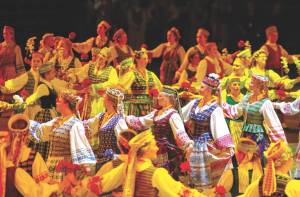 She explained that her granddaughters understand Lithuanian but have trouble speaking. One of her granddaughters interned at a NATO program in Lithuania the previous summer.
She explained that her granddaughters understand Lithuanian but have trouble speaking. One of her granddaughters interned at a NATO program in Lithuania the previous summer.
Putinas Mašalaitis, Anilora’s husband, leaned into the conversation as well. “The folk dance festival is a way to return young people to Lithuania. Everything begins with those young people who want to dance.”
The lights were dimmed, and the program began. We ceased our conversation. To everyone’s pleasure and amazement, President Gitanas Nausėda strolled confidently onto the stage and delivered a greeting to the dancers and to the audience. He invited all North American diaspora Lithuanians to return to Lithuania.
After the uplifting mood created by the vibrant dance performance, dancers hugged each other, thrilled and sad that the show was now over. Parents hugged children. Grandparents gushed. People shared their impressions. I walked among the dancers bedecked in their colorful Lithuanian national costumes and members of the audience, talking with anyone who cared to share their impressions with me. With some, I only managed to exchange a few words before they rushed off in the excitement of the moment, while with others I maintained a longer in-depth discussion. I made it a point to record the impressions of people of different ages, backgrounds, and who came from different parts of the country.
I spoke with Erikas Adomaitis, a young man of 33 with a thick dark brown beard and thick brown hair that reached to his collar. Erikas told me that he was a dancer with the dance group “Pūga” from Minneapolis, Minnesota. He shared with me that he was a fourth generation Lithuanian American and that he was a descendant of Lithuanian coal miners and had been born in Pennsylvania. His great-grandparents and grandparents had immigrated to the United States from Lithuania in the early 20th century and worked hard all their lives in the coal mines. He recalled that his grandfather said, “Tep” and not “Taip,” but unfortunately was unable to learn Lithuanian from his grandparents as a child. Now he was teaching himself Lithuanian by reading a bilingual edition of the Lithuanian poet Marcelijus Martinaitis’s book of persona poems, The Ballads of Kukutis. A few years previous Erikas had relocated from Pennsylvania to Minnesota where he met Nerijus Gulbickas and Darius Jankauskas, third wave immigrants from Lithuania who had come to Minneapolis to work. They invited him to join their dance group. Now he was learning not only to dance Lithuanian folk dances, but how to speak Lithuanian from them. Erikas was rediscovering his Lithuanian roots by dancing together with recent immigrants from Lithuania and was tremendously happy that this fortuitous opportunity had presented itself. It’s truly fascinating how members of two waves of Lithuanian immigration, separated by a century, have befriended each other through dance.
I spoke with Nerijus’s fourteen-year-old son Šarūnas, who had traveled from Minneapolis with his father to watch his father dance in the program. His wild curly black hair was pulled back into a ponytail.
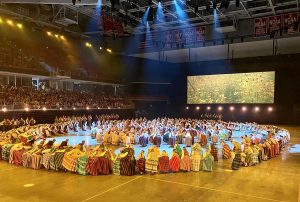 “I’m here to support my dad,” Šarūnas explained cheerfully. “I’ve never seen such a program in my life!” he added with enthusiasm. “It was colorful, beautiful. I’m so proud of my father for dancing in such an amazing program. It’s really cool!”
“I’m here to support my dad,” Šarūnas explained cheerfully. “I’ve never seen such a program in my life!” he added with enthusiasm. “It was colorful, beautiful. I’m so proud of my father for dancing in such an amazing program. It’s really cool!”
“Your mom’s not a Lithuanian?” I guessed. “She’s American. Is she here?”
“Yes. She couldn’t come.”
“What does she think about you being here at the folk-dance festival?”
“Mom loves it!” Šarūnas said with enthusiasm, “she was so impressed when I told her over the phone that the President of Lithuania flew here just to watch the folk-dance festival and to greet all the dancers.”
When the father and son walked off, I spoke to another fourteen-year-old, Greta. Her blond hair was neatly plaited, and her national costume was well put together. She danced with the group “Vėjas” from Elizabeth, New Jersey. I asked Greta why she had danced today.
Greta responded in Lithuanian, “I dance because I like it.”
Like Šarūnas, she was from a mixed Lithuanian and American family (her mother had immigrated from Lithuania and her father was American).
“It’s all so beautiful to me,” Greta said about the show, “everyone put so many hours into rehearsals, and you can really see that from the results.”
“Would you like to return to Lithuania to live?” I asked.
“Yes, I would, because I am from Lithuania. When I spend the summers in Lithuania, I feel completely at home. My family goes to Lithuania every other year.”
After I wished Greta well, I recognized an acquaintance from Chicago, Ramunė. She was dressed in a beautiful Lithuanian national costume that set off her closely cropped grayish blond hair. Despite turning 65 this year, she was still dancing in the program.
“Why do you dance Lithuanian folk dances?” I asked.
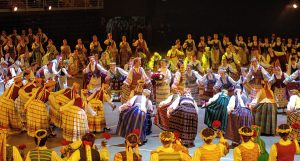 “I’ve danced since I was a little girl, and I enjoy it,” Ramunė said, but then acknowledged that she made a few mistakes while dancing and would have liked to fix them. “But…” she is not able to complete her sentence because friends from her group join her and pull her off to laugh and share impressions in their circle.
“I’ve danced since I was a little girl, and I enjoy it,” Ramunė said, but then acknowledged that she made a few mistakes while dancing and would have liked to fix them. “But…” she is not able to complete her sentence because friends from her group join her and pull her off to laugh and share impressions in their circle.
I turned around and saw Aistė, a lovely brunette with blue eyes, who is 28, and from Manhattan. She danced with the New York City dance group “Tryptinis.” I’ve known Aistė since she was an infant, so I did not hesitate to ask her a few questions. My first question was why she was dancing today.
Aistė smiled wide. Happily, she recounted all her reasons: “It’s an opportunity to be together, to spend time with your friends, your family. This is a joyous holiday when you feel that you truly belong to a community that is like family to you, and that together you work hard to create something beautiful, something unforgettable.”
I asked Aistė if she would like to return to Lithuania.
“Why not? I would go back to work. I’d need to have a clear goal why I was relocating to Lithuania, but yes, I admit, I’d like to live in Lithuania. I’d like to spend a longer time there so that I could see friends, family members, who live in Lithuania.”
I spoke with Paul, who lives in Brooklyn with his eight-year-old daughter, Aylin. She was dancing with the Mairionis Lithuanian School dance group, and Paul had been a parent helper for the group. This was his daughter’s first folk dance festival.
“It’s very important to me that my daughter participate in Lithuanian community activities and that she feels like a Lithuanian,” Paul explained. “Besides, she enjoys dancing and playing with her friends from the dance group because they all attend Saturday School together. Her mother is from Moscow and speaks with her in Russian. I’m teaching her Lithuanian. In school, she speaks English. She speaks all three languages fluently. When she grows up, she’ll be able to come to her own conclusions about her heritage and sort all of that out.”
An olive-skinned young man with black hair strides past dressed in a man’s Lithuanian national costume. I know that his name is Juan and that he is a dancer with “Tryptinis” from New York. He is from Colombia. I’m curious to learn how he joined the Lithuanian dance group, thinking that perhaps he has Lithuanian roots? After all, there was an old and sizeable Lithuanian South American community in Colombia. Growing up, I’d had Lithuanian friends from this Lithuanian emigre community in Colombia. I asked Juan about his heritage, and it turned out he is 100 percent Colombian and not a drop Lithuanian.
“When I was a student,” Juan explained, “I was friends with a group of Lithuanians. They told me about this dance group and explained where to go to rehearsal. The first time I went there, I sincerely thought that I was going to dance salsa, but no, it turns out that they were doing Lithuanian folk dances. I liked the dances, and I started to dance with them. I’ve been dancing a long time now, since before the pandemic. I really enjoyed preparing for this dance festival. Lithuanians are very friendly people. They accepted me into their group.”
A middle-aged couple from New York approached our group. Husband and wife, Danius and Judita danced with “Tryptinis.” It was clearly hard for them because they both complained of back pain and exhaustion, but that didn’t stop them from dancing.
Judita told me her story: “My parents were World War II war refugees. The Lutheran priest Jonas Pagauna sponsored them to come to the United States from the DP camp in Germany. His church brought over 500 war refugees, both Germans and Lithuanians. My parents were Lutherans, so they kept themselves separate from the Catholic Lithuanians, who were the majority, and who organized the Lithuanian folk dance festivals and other activities. That’s why I never danced in a dance group as a child. I discovered Lithuanian folk dance when I was 27 and I married my husband, who is from Vilnius, Lithuania. All three of our children have danced in many Lithuanian folk dance festivals over the years”.
I asked Judita’s husband, Danius, a restoration architect, who’d now spent more years of his life living in New York than Vilnius, why he dances.
“I’m really not much of a dancer,” Danius admitted. “I spend the whole time I’m out there concentrating on not making a mistake or heading off in the wrong direction. But my wife really wants to dance, and she asked me to dance with her, so, knowing how important this is for my wife, I agreed.”
I joined members of the New York Tryptinis group for dinner and sat down at the long table in the restaurant across from Lina and Asta. Lina immigrated to New York from Lithuania in 2005. She was born in 1981, so she’d lived through the early years of Lithuania’s independence as a child. She left Lithuania so she could see and experience more of the world.
“I danced in my first folk dance festival in Baltimore in 2016,” Lina explained. “I absolutely loved it! I fell in love with Lithuania while living in America. Here I felt that deep love for Lithuania that I hadn’t felt as much back in Lithuania. I felt the patriotism of Lithuanian Americans, their sincerity, their dedication to Lithuania.”
“This is only my second time in America,” Asta said, “but today I wrote on my Facebook page that if you want to experience the feeling of true love for Lithuania, then come to America. Here I realized that the love Lithuanian Americans feel for Lithuania is not at all put on or fake, but it’s real and it’s deep. It’s authentic. Just in these past few days, experiencing this dance festival, I’ve been so emotionally moved by people’s genuineness, sincerity, generosity. I’m so grateful that I’ve been able to experience this. The Lithuanian Folk Dance Festival here in America has been life changing for me”
“After 17 years in America, I’m returning to Lithuania,” Lina said.
“Why did you make that decision?” I asked.
“For love, because I met Asta and fell in love with her, and she lives in Lithuania. But that’s not the only reason. Even before I met her, I was seriously considering going back to live in Lithuania. Lithuanian society has changed radically for the better. People are much more open now, and Lithuania has moved forward so much since I left. There is innovation now, fresh ideas, energy. In America I learned how to live in a democracy. If you want to change something, then you need to go out and organize and get people to work together with you to make changes. I plan on being politically active in Lithuania. I’ve already found a job and I’ve already signed up to dance in the Vilnius folk dance group “Sugrįžus.” I am also planning on immediately joining the Lithuanian National Guard (Šauliai) and getting training to fight and defend Lithuania if there is a war. I will give my oath and swear to defend Lithuania.”
“Lina will defend the Homeland with a gun,” Asta said with a smile, “and I will volunteer as a nurse.”
After all that talk, after absorbing so many impressions and positive emotions, after having sung the Lithuanian National anthem the next day together with my fellow Lithuanians in the Freedom Park in Philadelphia, as all of America celebrated Independence Day, I reflected with satisfaction on how varied, how open, how friendly, and how strong is our global Lithuanian nation. And all of that is expressed through dance – the Lithuanian folk dances that bring all of us together, holding each other’s hands in the dance circle.
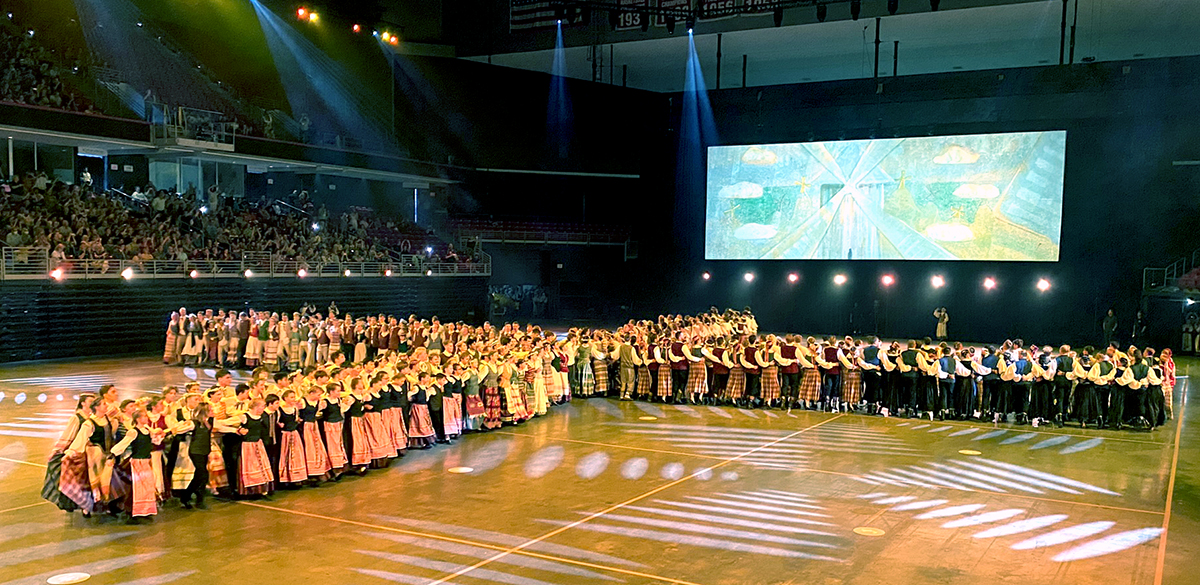
The article was published in “Draugas NEWS”, July 2022 edition.
 DRAUGAS NEWS Lithuanian World Wide News in English
DRAUGAS NEWS Lithuanian World Wide News in English
